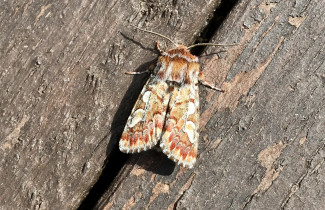The Mahogany trees Cedro and Caoba (Cedrela odorata and Swietenia macrophylla) affect the right-forewing of their unwelcome guest, the Mahogany shoot borer, which could later influence its flying abilities and pest management, a new study shows.
Hypsipyla grandella, or the Mahogany shoot borer, has a heavy impact on Cedro and Caoba trees, restricting their plantations. But at the same time, these trees affect the right-forewing of the moth-pest in size and form.
The Mahogany shoot borer is one of the most important forest insect-pests in the South and Central America, where it devastates Cedro and Caoba forest plantations. It destroys the trees’ leading shoots and could affect all plants in a forest stand, resulting in forked trees without commercial value. Although both Cedro and Caoba are highly appreciated for the beauty and workability of their wood, the biology of the Mahogany shoot borer is poorly known.
Research shows that the Mahogany shoot borer prefers Cedro over Caoba. Meanwhile, other research indicates that the form and size of moths and butterflies are affected by their host. In the new study, researchers wanted to study if the form and size of the Mahogany shoot borer is affected by whether its host is Cedro or Caoba. To study this, they focused on the right-forewing of the moth and used a technique called geometric morphometry to evaluate changes in the wing form and size. The wing was chosen for analysis, since in moths and butterflies, wings are very important for migration, territorialism and courtship, and to escape from enemies.
The researchers found that the wing form differs between males and females, and when the host was Cedro, the wing was larger. These findings are common in moths and butterflies, but what is uncommon is that only the male wing form differed between the hosts.
An important question is if the observed differences in wing form and size could influence the species’ flying system, as reported in other butterflies and moths. For example, for long-distance flights it is important to have a long forewing with a narrow tip, and for controlled flights, a small and broad forewing is important. According to the researchers, the host could affect the systems for controlling damages caused by the Mahogany shoot borer, as when the host is Cedro, the moth could fly longer distances, and when the host is Caoba, the moth could have more controlled flights. These findings could help to guide future plantings of Cedro and Caoba, taking into account that moths with larger right-forewings could be more frequent in Cedro, having better capabilities for long-distance flights, which is not ideal in integrated pest management systems.
The study was funded by Corporación Colombiana de Investigación Agropecuaria – AGROSAVIA under the project “Strategies for planning and management of forest plantations and agroecosystems in Colombia”, led by Jhon Jairo Zuluaga Pelaéz.
Research article:
PULGARÍN D., J.A. CAÑAS M., V., PÉREZ-PÉREZ, J., & MÁRQUEZ, E. J. (2023). Size and shape variation of Hypsipyla grandella Zeller (Lepidoptera: Pyralidae) in two hosts: A morphometric approach. Zoologischer Anzeiger, 302, 304-309. https://doi.org/10.1016/j.jcz.2022.12.005


